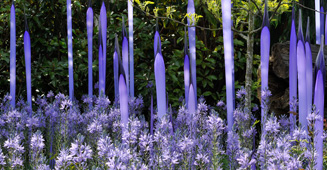

Contributor
- Topics: Archive

Chihuly Garden and Glass
305 Harrison Street
Seattle, Washington 98109
When the idea of creating a garden and a temporary exhibition space at the foot of Seattle’s Space Needle was first conceived, vintage automobiles were considered as a possible draw for the visiting public. Richard Hartlage, currently a principal in the Seattle-based landscape design firm Land Morphology, became aware of the project through one of his clients on the Space Needle’s board of directors. It was not long until the idea evolved into a landscape and gallery space featuring the work and collections of the world-renowned artist Dale Chihuly, whose fantastical glassworks have been the center of successful installations at botanical gardens and sites around the world.
Chihuly’s first garden installation at the Jens Jensen-designed greenhouse in Garfield Park on Chicago’s West Side in 2001, followed by shows at the New York Botanical Garden and Royal Botanic Garden, Kew, drew record crowds. It seemed like an ideal match to set this Washington State native’s work at the foot of one of the city’s most recognizable structures. The Space Needle was built for the 1962 World’s Fair at the Seattle Center and like the Space Needle, Chihuly’s work exhibits a balance of artistry and engineering. With this in mind, the Wright family, who were instrumental in building the Space Needle and continue to steward Seattle Center development, approached Chihuly about the creation of a showcase for his work. He enthusiastically accepted their offer.

Today, Chihuly Garden and Glass covers an acre and a half on the Seattle Center grounds and represents a collaboration of public planning, architecture, artwork, and landscape design. The glasshouse and interior galleries house a collection of Chihuly’s colorful glass sculptures, drawings, and collections that have influenced his work. Inspired by everything from local Native American basketwork and Pacific Northwest sea creatures, to flower and plant forms that have intrigued him since his childhood in Tacoma, Chihuly’s work includes floats that mimic those in Puget Sound, fantastical hanging chandeliers that hint at his time studying at the Venetian glassmaker Venini, and a florally inspired Persian glass ceiling that tops one of the gallery spaces. A 100-foot-long art piece floats at the top of the glass house. Transformed throughout the day and seasons in response to the changing light the work can be seen from the garden as visitors approach.

From the beginning, a garden was part of the plan for the site. But when a feasibility study estimated that annual visitors would top 500,000, the landscape aspect of the project took on another dimension—traffic control. The space surrounding the glasshouse, which was conceived as a sculpture garden once Chihuly signed on to the project, needed to be able to handle crowds and lead visitors toward the indoor exhibit space. The architect Owen Richards, of Owen Richards and Associates, and landscape designer Richard Hartlage, started looking at the layout of the area and began developing paths that could handle the crowds but would also build a sense of drama and create a grand entrance for Chihuly Garden and Glass (something that seems like it would come naturally to the six-foot-four, nattily dressed Hartlage).
The space not only needed to have four-season appeal it also needed to respond to the artworks that Chihuly and his studio team were placing throughout the garden. Both the artist and the landscape designer wanted the artworks and the plantings to feel integrated with one another throughout the garden, seeing them as parts of a unified whole. Hartlage wanted the garden, like Chihuly’s artworks, to be intellectually accessible and joyful. As he says, “One does not need to understand art history to love Dale’s work. The garden is meant to echo that accessibility. It is a beautiful, joyful garden.” For those with a deeper knowledge of plants or an understanding of the history of studio glass, there may be another level of appreciation, but both garden and glass serve to inspire those new to either field with their beauty, color, and exuberance.

What evolved are various matrix plantings of layered bulbs and perennials that are constantly in flux as the seasons progress. Compositions were selected for their relationship to each work. A mixed evergreen hedge that reveals the plantings to visitors as they approach the glass house and interior exhibition space contains the finished garden, which ended up covering about three-quarters of an acre when all was said and done.

Hartlage claims that working with Chihuly on the project was a delight and that the only dictate from the artist was that the selected plant material should not exactly match the color of the artwork in the area, or completely contrast with the artwork. Within these loose parameters was room for an endless display of playful plantings. A bed of black mondo grass (Ophiopogon planiscapus ‘Nigrescens’) sits like a circular, aged-bronze plinth beneath Pacific Sun. And endless, mixed perennial plantings with seasonal annuals—ornamental alliums, Geranium ‘Rozanne’, and silver sea hollies, together with a mixture of pansies, white ornamental cabbages, and an array of spring ephemerals—offset other Chihuly works such as the lavender glass reeds at the north end of the garden. As Hartlage puts it: “The glass is static, the plants evolve. In the areas where there are perennial plantings, they need to perform in succession throughout the season. We wanted five and seven changes of color in each square foot of bed.”

The design process was hands-on, more so than in a typical public garden. Even for the Chihuly studio, which is accustomed to botanic garden installations, the approach was out of the ordinary because most of their previous installations were set into existing gardens. Both aspects of the project—garden and glass—moved forward in unison. PVC pipes and plywood placeholders stood in for the artworks as the garden was built around them. Pieces selected for the sculpture garden had to be made from thicker pieces of blown glass than works that were designed for indoor display so they could survive life outdoors. “It was terrifying,” confesses Hartlage, “but nothing was broken in the plant installation. I was so relieved.”
The project broke ground on construction of the glasshouse and hardscape in August 2011, and the garden was built on a tight time frame of three and one-half months starting in late summer 2012. Hartlage spent days on end at the site, laying out and reworking plantings as the design evolved. Hartlage admits the first year at the garden was difficult. The soil was compacted during the construction process and needed to be air-spaded, a mechanical process commonly used to aerate soil around trees after construction to alleviate soil compaction. Before air-spading, the plants did not perform at their best. Today, he is delighted that the plants have come into their own and, although his design team still heavily consults on plantings and changes at the garden, Hartlage credits the staff gardener, Rachel Millard, for much of the garden’s impeccable maintenance. “She is self-taught and perhaps one of the most talented gardeners with whom I have ever worked.”

Hartlage would love to see the garden become a certified botanic garden because its plant collections merit such stewardship. But he also wants the garden—in the tradition of Russell Page’s Sculpture Garden at Pepsico in White Plains, New York, and Hudson Valley’s Storm King—to simply be a place “where people can be inspired by experiencing art and plants integrated into a built form.”

Hartlage credits the successful development of Chihuly Garden and Glass to the entire team that worked on the garden, their architectural partners, Dale Chihuly and his studio, and the horticultural design and installation crew. He sums up his advice for good place-making thus: “Whether a person is working at creating elaborately crafted and expressive works of art in glass or designing and planting a garden, one has to be just as good a technician as one is an artist.”










Responses